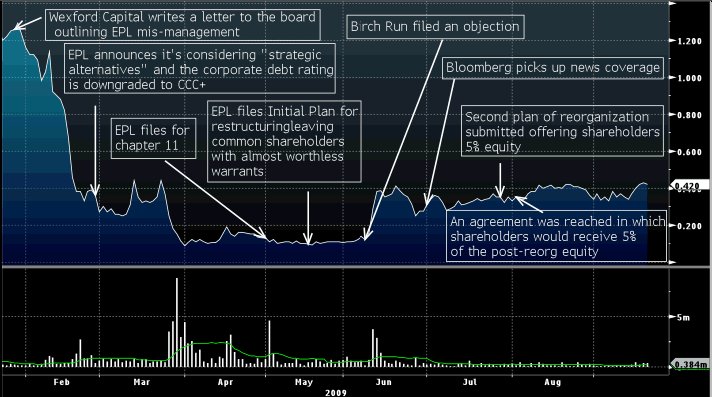Below is the second part in our series on “Distressed Debt Activism In The Age Of Electronic Media”. We will be presenting on this topic at the 6th Global Forum on Investing in Distressed Debt, and thought it fitting to discuss on our blog some of the case studies which we’ll be profiling. Last week, we examined the very public Pershing-Tilson-Hovde debate over General Growth Properties, and next week, we’ll cover our own work on Eagle Rock Energy. This week, we’ll profile the activism of Birch Run Capital in the bankruptcy of Energy Partners Ltd. (EPL), an oil & gas operator that filed for bankruptcy in May 2009.
As in GGP, EPL provides another case of a distressed debt activism in which the benefits to the activist went beyond the return on investment. Birch Run Capital, a value-oriented fund run by Daniel Beltzman and Greg Smith, first invested in EPL through its bonds, but soon realized that the equity was undervalued as well. But with no one yet challenging the proposed plan of reorganization or willing to fund the costs of forming an equity committee, it appeared shareholders wouldn’t be represented. The timeline below shows how the situation played out:
In the chart above, the objection filed by Birch Run was actually a 40 page valuation report employing a comparative analysis, a DCF, and the “standardized measure” estimates unique to oil and gas companies. The annotated stock chart shows how Birch Run’s filing immediately impacted the stock price.
Birch Run’s initial investment was in the bonds, at a price of around 50-55% of face, but as Birch Run became increasingly bullish on the equity, they eventually ended up owning a disproportionate share of the company’s stock. While the shares hovered in the $0.10 range, Birch Run was able to accumulate an equity position at low prices and coordinate with other large shareholders to oppose the bondholder-organized plan.
With the initial trial set for Wednesday, Birch Run submitted its “Equity Support Analysis” on Monday night. The judge allowed an extension so that remaining shareholders could organize, and Birch Run used that window to educate other potential large holders on the opportunity. This helped ensure that the existing plan would be voted down by equity holders. Also, in a rare move, the judge took financial advisors off the table unless they agreed to receive compensation only in the event the court determined their analysis was useful. No financial advisors took that risk.
The US Trustee formed an equity committee based on the compelling valuation submitted by Birch Run, a move supported by the judge. Bloomberg soon picked up the news, reporting the following:
“The movement for a shareholders’ committee began in earnest when New York based Birch Run objected to the disclosure statement and argued that the company’s own valuation showed the note holders as receiving $26 million more than their claims. Birch run believes the existing stock is worth $212 million.
Birch Run noted that the company’s valuation was based on oil prices that since have risen 38 percent. The bankruptcy judge called for the disclosure statement to contain material supplied by Birch Run.”
One month after the Bloomberg article, EPL filed an amended plan offering shareholders 5% of the equity in the reorganized company. The offer was still well below what the Birch Run report estimated would be fair, but the equity committee accepted it, since natural gas prices were falling; EPL was operating under a tight timeline implemented by the US Mineral Management Service before severe penalties could kick in; and the judge didn’t want the case to go to trial. Shares that had been trading in the 10 cent range would eventually be worth $0.75-$1.00, not a bad return in just a few months (the bonds also returned a solid result).
On top of the attractive returns, Birch Run also received compensation for legal expenses from EPL as per a fairly unusual “Substantial Contribution” opinion from the judge. The fund also benefited from press coverage and a triumphant story to share with investors. In this case, the benefits of openly defending the equity were numerous and well worth the effort.
As with GGP, the Birch Run / EPL case study is an example of how detailed presentations of hedge fund investment theses can have meaningful impacts in a Chapter 11 scenario. Simply from looking at the EPL annotated stock chart, it’s clear that Birch Run’s work triggered an immediate surge as well as a long-term increase in the stock price. While Birch Run did not “market” its thesis to the public, but instead submitted its valuation work as an objection to the disclosure statement, the ease of internet communication meant that the presentation found its way into the inboxes of many funds previously not involved in the stock. In the ensuing weeks, the flurry of new investors, as well as the mobilization of legacy equity holders, helped pressure bondholders to revise their plan of reorganization, and attribute more value to equity holders.






Add New Comment